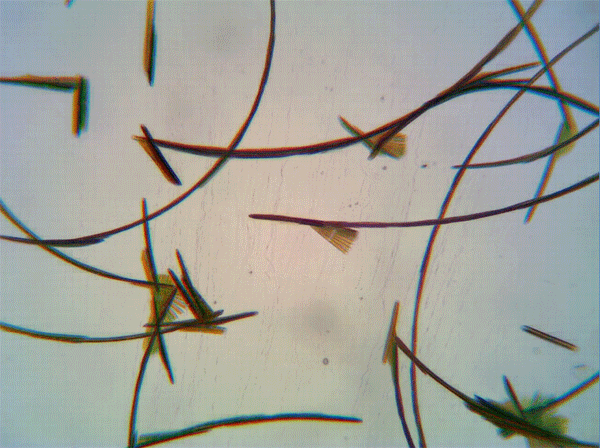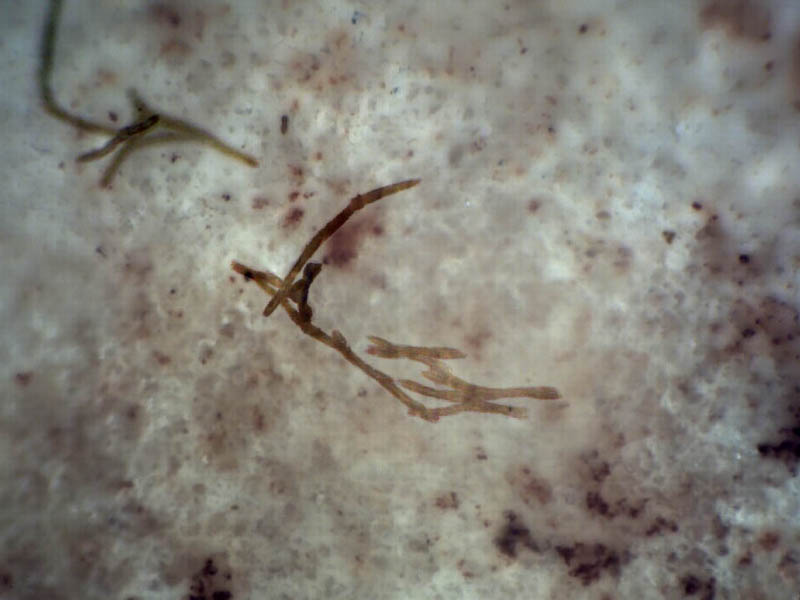|
Cymatopleura solea (60x time lapse) |
Cymatopleura solea "motion blur"-Filter (60x time lapse) |
Forms of the paths
When observing the movement of the diatoms with the view from above onto the substrate on which diatoms move, then one often notices almost circular, spiral or straight paths, which are interrupted again and again by reversals of direction. As mentioned earlier, a back-and-forth jerking or pivoting movement takes place around large angles, depending on the species. Particularly in small diatoms, in combination with the linear movement, a wagging occurs around the direction of movement.
An example of such paths is shown in the video above. On the left, the movement of some Cymatopleura solea (Length: approx. 180 µm) in a still sparsely populated petri dish can be seen in 60x time lapse. The video to the right was made by using VirtualDub, whereby the paths were highlighted by the 40-times application of the filter "motion blur".

The animated picture on the left shows how perfect a circle is sometimes passed through. In the picture the paths of several Nitzschia of the same species are marked by red dashed circles. The circles have different radii. The largest has a radius of slightly less than a millimeter.
These regular paths are an artifact under laboratory conditions, because here the diatoms move on smooth surfaces. In nature the substrate consists, for example, of a rough surface of a stone or of rugged plant surface with a complex structure. Even before the irregularities in thickness of the substrate reach the order of the height of the diatom, the path is significantly disturbed. On precisely circular paths, reversals of direction alone would not make it possible to change the position beyond the circle. Nevertheless, the recordings of the motion on smooth substrates are of particular interest because they are almost free from disturbances and allow conclusions on the mechanisms of motion.
 The picture on the left shows the paths of unknown diatoms. Here a small pebble from a brook was observed in reflected light. From a short video a typical image of a motion path in nature resulted from the minimum of all frames. One only recognizes rudimental circular paths. Nothing is known about the species and it is unclear how the corresponding motion would look on a smooth substrate. This situation can easily be simulated with a known species from a culture. For this purpose, a sterilized flat pebble was placed in a petri dish with nutrient solution. Afterwards, it was inoculated with a few clearly distinguishable species. After a few days the following video was recorded, in which one sees in particular all Craticula cuspidata (Length: approx. 120 µm) in motion. The recording time was 600 seconds. On the right, you can see the paths that were calculated from the video (click to enlarge).
The picture on the left shows the paths of unknown diatoms. Here a small pebble from a brook was observed in reflected light. From a short video a typical image of a motion path in nature resulted from the minimum of all frames. One only recognizes rudimental circular paths. Nothing is known about the species and it is unclear how the corresponding motion would look on a smooth substrate. This situation can easily be simulated with a known species from a culture. For this purpose, a sterilized flat pebble was placed in a petri dish with nutrient solution. Afterwards, it was inoculated with a few clearly distinguishable species. After a few days the following video was recorded, in which one sees in particular all Craticula cuspidata (Length: approx. 120 µm) in motion. The recording time was 600 seconds. On the right, you can see the paths that were calculated from the video (click to enlarge).
For comparison, a very sparsely populated culture was filmed in a petri dish over the same period under the same light conditions. The video and the paths are shown below.
Although such experiments show strong variability, the influence of a rough substrate is unmistakable.
It should be noted that there are also cases where movement is restricted by colony formation. For example, Bacillaria paxillifera can only move relative to their adjacent diatoms, which leads to a movement of the entire colony (see video). The question of the path curvature of a diatom does not arise at all.
Many motile diatoms do not show any motion as long as they are bound in colonies, but they can move as individuals or in small groups (see Eunotia and Cymbella).
Another example are tube-dwelling diatoms as seen in a water sample from a small pond in the video on the left below (unfortunately, cultivation of these tube-dwelling Encyonema caespitosum was not successful). The degrees of freedom of movement are restricted by the tube and the distance that can be covered is narrowed by the positions of the neighbouring diatoms. Tube-dwelling Frustulia vulgaris from the river Neckar (locality: Lauffen am Neckar) can be found in the video to the right. The high elasticity of the tube is striking.
|
Tube-dwelling Encyonema caespitosum (60x time lapse) |
Tube-dwelling Frustulia vulgaris (60x time lapse) |
On the following pages the kinematics, i.e. the formal description of the motion paths, and the boundary conditions for the analysis will be discussed. Afterwards, the visualization and the tracking of the trajectories will be briefly presented. Analysis methods and results of the analysis follow in the last chapter (see menu on the left).





